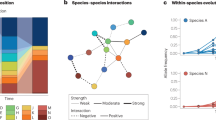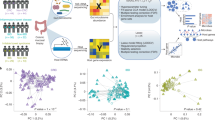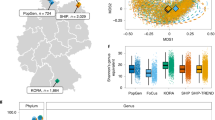Abstract
The gastrointestinal (GI) ecosystem is increasingly understood to be a fundamental component of health, and has been identified as a new focal point for diagnosing, correcting and preventing countless disorders. Shotgun DNA sequencing has emerged as the dominant technology for determining the genetic and microbial composition of the gut microbiota. This technology has linked microbiota dysbioses to numerous GI diseases including inflammatory bowel disease, obesity and allergy, and to non-GI diseases like autism and depression. The importance of establishing causality in the deterioration of the host–microbiota relationship is well appreciated; however, discovery of candidate molecules and pathways that underlie mechanisms remains a major challenge. Targeted approaches, transcriptional assays, cytokine panels and imaging analyses, applied to animals, have yielded important insight into host responses to the microbiota. However, non-invasive, hypothesis-independent means of measuring host responses in humans are necessary to keep pace with similarly unbiased sequencing efforts that monitor microbes. Mass spectrometry-based proteomics has served this purpose in many other fields, but stool proteins exist in such diversity and dynamic range as to overwhelm conventional proteomics technologies. Focused analysis of host protein secretion into the gut lumen and monitoring proteome-level dynamics in stool provides a tractable route toward non-invasively evaluating dietary, microbial, surgical or pharmacological intervention efficacies. This review is intended to guide GI biologists and clinicians through the methods currently used to elucidate host responses in the gut, with a specific focus on mass spectrometry-based shotgun proteomics applied to the study of host protein dynamics within the GI ecosystem.
Similar content being viewed by others
Log in or create a free account to read this content
Gain free access to this article, as well as selected content from this journal and more on nature.com
or
References
Addona Ta, Abbatiello SE, Schilling B, Skates SJ, Mani DR, Bunk DM et al. (2009). Multi-site assessment of the precision and reproducibility of multiple reaction monitoring-based measurements of proteins in plasma. Nat Biotechnol 27: 633–641.
El Aidy S, van Baarlen P, Derrien M, Lindenbergh-Kortleve DJ, Hooiveld G, Levenez F et al. (2012). Temporal and spatial interplay of microbiota and intestinal mucosa drive establishment of immune homeostasis in conventionalized mice. Mucosal Immunol 5: 567–579.
Athanasiadou S, Jones La, Burgess STG, Kyriazakis I, Pemberton AD, Houdijk JGM et al. (2011). Genome-wide transcriptomic analysis of intestinal tissue to assess the impact of nutrition and a secondary nematode challenge in lactating rats. PLoS One 6: e20771.
Bern M, Kil YJ, Becker C . (2012). Byonic: advanced peptide and protein identification software. Curr Protoc Bioinformatics Chapter 13: Unit13.20. doi:10.1002/0471250953.bi1320s40.
Cash H, Whitham C, Behrendt C . (2006). Symbiotic bacteria direct expression of an intestinal bactericidal lectin. Science 313: 1126–1130.
Human Microbiome Project Consorium. (2012). Structure, function and diversity of the healthy human microbiome. Nature 486: 207–214.
Costello EK, Lauber CL, Hamady M, Fierer N, Gordon JI, Knight R . (2009). Bacterial community variation in human body habitats across space and time. Science 326: 1694–1697.
Erickson AR, Cantarel BL, Lamendella R, Darzi Y, Mongodin EF, Pan C et al. (2012). Integrated metagenomics/metaproteomics reveals human host-microbiota signatures of Crohn’s disease. PLoS One 7: e49138.
Le Gall G, Noor SO, Ridgway K, Scovell L, Jamieson C, Johnson IT et al. (2011). Metabolomics of fecal extracts detects altered metabolic activity of gut microbiota in ulcerative colitis and irritable bowel syndrome. J Proteome Res 10: 4208–4218.
Gillet LC, Navarro P, Tate S, Röst H, Selevsek N, Reiter L et al. (2012). Targeted data extraction of the MS/MS spectra generated by data-independent acquisition: a new concept for consistent and accurate proteome analysis. Mol Cell Proteomics 11: 016717.
Gygi SP, Rochon Y, Franza BR, Aebersold R . (1999). Correlation between protein and mRNA abundance in yeast correlation between protein and mRNA abundance in yeast. Mol Cell Biol 19: 1720–1730.
Habib AM, Richards P, Cairns LS, Rogers GJ, Bannon CAM, Parker HE et al. (2012). Overlap of endocrine hormone expression in the mouse intestine revealed by transcriptional profiling and flow cytometry. Endocrinology 153: 3054–3065.
Hansson J, Panchaud A, Favre L, Bosco N, Mansourian R, Benyacoub J et al. (2011). Time-resolved quantitative proteome analysis of in vivo intestinal development. Mol Cell Proteomics 10: 005231.
Hsiao EY, McBride SW, Hsien S, Sharon G, Hyde ER, McCue T et al. (2013). Microbiota modulate behavioral and physiological abnormalities associated with neurodevelopmental disorders. Cell 155: 1451–1463.
Hsu JL, Huang SY, Chow NH, Chen SH . (2003). Stable-isotope dimethyl labeling for quantitative proteomics. Anal Chem 75: 6843–6852.
Hughes CS, Foehr S, Garfield Da, Furlong EE, Steinmetz LM, Krijgsveld J . (2014). Ultrasensitive proteome analysis using paramagnetic bead technology. Mol Syst Biol 10: 757–757.
Ideker T, Thorsson V, Ranish Ja, Christmas R, Buhler J, Eng JK et al. (2001). Integrated genomic and proteomic analyses of a systematically perturbed metabolic network. Science 292: 929–934.
Ivanov II, Atarashi K, Manel N, Brodie EL, Shima T, Karaoz U et al. (2009). Induction of intestinal Th17 cells by segmented filamentous bacteria. Cell 139: 485–498.
Kennedy J, Abbatiello S, Kim K . (2014). Demonstrating the feasibility of large-scale development of standardized assays to quantify human proteins. Nat Methods 11: 149–155.
Kim YS, Ho SB . (2010). Intestinal goblet cells and mucins in health and disease: recent insights and progress. Curr Gastroenterol Rep 12: 319–330.
Klaassens ES, de Vos WM, Vaughan EE . (2007). Metaproteomics approach to study the functionality of the microbiota in the human infant gastrointestinal tract. Appl Environ Microbiol 73: 1388–1392.
Koeth Ra, Wang Z, Levison BS, Buffa Ja, Org E, Sheehy BT et al. (2013). Intestinal microbiota metabolism of L-carnitine, a nutrient in red meat, promotes atherosclerosis. Nat Med 19: 576–585.
Lankisch PG . (1993). Function tests in the diagnosis of chronic pancreatitis. Critical evaluation. Int J Pancreatol 14: 9–20.
Laukens D, Peeters H, Cruyssen BV, Boonefaes T, Elewaut D, De Keyser F et al. (2006). Altered gut transcriptome in spondyloarthropathy. Ann Rheum Dis 65: 1293–1300.
Ley R, Hamady M, Lozupone C, Turnbaugh P, Ramey RR, Bircher JS et al. (2008). Evolution of mammals and their gut microbes. Science 320: 1647–1652.
Li J, Jia H, Cai X, Zhong H, Feng Q, Sunagawa S et al. (2014). An integrated catalog of reference genes in the human gut microbiome. Nat Biotechnol 32: 834–841.
Lichtman JS, Marcobal A, Sonnenburg JL, Elias JE . (2013). Host-centric proteomics of stool: a novel strategy focused on intestinal responses to the gut microbiota. Mol Cell Proteomics 12: 3310–3318.
Loser C, Mollgaard A, Folsch UR . (1996). Faecal elastase 1: a novel, highly sensitive, and specific tubeless pancreatic function test. Gut 39: 580–586.
Ma B, Zhang K, Hendrie C, Liang C, Li M, Doherty-Kirby A et al. (2003). PEAKS: powerful software for peptide de novo sequencing by tandem mass spectrometry. Rapid Commun Mass Spectrom 17: 2337–2342.
Marcobal A, Kashyap PC, Nelson TA, Aronov PA, Donia MS, Spormann A et al. (2013). A metabolomic view of how the human gut microbiota impacts the host metabolome using humanized and gnotobiotic mice. ISME J 7: 1933–1943.
Maslowski KM, Vieira AT, Ng A, Kranich J, Sierro F, Yu D et al. (2009). Regulation of inflammatory responses by gut microbiota and chemoattractant receptor GPR43. Nature 461: 1282–1286.
Nicholson JK, Holmes E, Wilson ID . (2005). Gut microorganisms, mammalian metabolism and personalized health care. Nat Rev Microbiol 3: 431–438.
Qin J, Li R, Raes J, Arumugam M, Burgdorf KS, Manichanh C et al. (2010). A human gut microbial gene catalogue established by metagenomic sequencing. Nature 464: 59–65.
Resing Ka, Meyer-Arendt K, Mendoza AM, Aveline-Wolf LD, Jonscher KR, Pierce KG et al. (2004). Improving reproducibility and sensitivity in identifying human proteins by shotgun proteomics. Anal Chem 76: 3556–3568.
Ross PL, Huang YN, Marchese JN, Williamson B, Parker K, Hattan S et al. (2004). Multiplexed protein quantitation in Saccharomyces cerevisiae using amine-reactive isobaric tagging reagents. Mol Cell Proteomics 3: 1154–1169.
Saric J, Wang Y, Li J, Coen M, Utzinger J, Marchesi JR et al. (2008). Species variation in the fecal metabolome gives insight into differential gastrointestinal function. J Proteome Res 7: 352–360.
Shkoda A, Werner T, Daniel H, Gunckel M, Rogler G, Haller D . (2007). Differential protein expression profile in the intestinal epithelium from patients with inflammatory bowel disease. J Proteome Res 6: 1114–1125.
Smith P, Howitt M, Panikov N . (2013). The microbial metabolites, short-chain fatty acids, regulate colonic Treg cell homeostasis. Science 80: 569–574.
Snel J, Heinen PP, Blok HJ, Carman RJ, Allen PC . (1995). Comparison of 16 S rRNA sequences of segmented filamentous bacteria isolated from mice, rats, and chicketns and proposal of “Candidatus Arthromitus.”. Int J Syst Bacteriol 45: 780–782.
Sokol H, Pigneur B, Watterlot L, Lakhdari O, Bermúdez-Humarán LG, Gratadoux J-J et al. (2008). Faecalibacterium prausnitzii is an anti-inflammatory commensal bacterium identified by gut microbiota analysis of Crohn disease patients. Proc Natl Acad Sci USA 105: 16731–16736.
Spor A, Koren O, Ley R . (2011). Unravelling the effects of the environment and host genotype on the gut microbiome. Nat Rev Microbiol 9: 279–290.
Swidsinski A, Loening-Baucke V, Theissig F, Engelhardt H, Bengmark S, Koch S et al. (2007). Comparative study of the intestinal mucus barrier in normal and inflamed colon. Gut 56: 343–350.
Swidsinski A, Sydora B . (2007). Viscosity gradient within the mucus layer determines the mucosal barrier function and the spatial organization of the intestinal microbiota. Inflamm Bowel Dis 13: 963–970.
Swidsinski A, Weber J, Loening-Baucke V, Hale LP, Lochs H . (2005). Spatial organization and composition of the mucosal flora in patients with inflammatory bowel disease. J Clin Microbiol 43: 3380–3389.
Turnbaugh PJ, Hamady M, Yatsunenko T, Cantarel BL, Duncan A, Ley RE et al. (2009). A core gut microbiome in obese and lean twins. Nature 457: 480–484.
Turnbaugh PJ, Ridaura VK, Faith JJ, Rey FE, Knight R, Gordon JI . (2009). The effect of diet on the human gut microbiome: a metagenomic analysis in humanized gnotobiotic mice. Sci Transl Med 1: 6ra14.
Vaishnava S, Hooper LV . (2007). Alkaline phosphatase: keeping the peace at the gut epithelial surface. Cell Host Microbe 2: 365–367.
Vaishnava S, Yamamoto M, Severson KM, Ruhn KA, Yu X, Koren O et al. (2011). The antibacterial lectin RegIIIgamma promotes the spatial segregation of microbiota and host in the intestine. Science 334: 255–258.
Verberkmoes NC, Russell AL, Shah M, Godzik A, Rosenquist M, Halfvarson J et al. (2009). Shotgun metaproteomics of the human distal gut microbiota. ISME J 3: 179–189.
Werner T, Sweetman G, Savitski MF, Mathieson T, Bantscheff M, Savitski MM . (2014). Ion coalescence of neutron encoded TMT 10-plex reporter ions. Anal Chem 86: 3594–3601.
Whiteaker JR, Lin C, Kennedy J, Hou L, Trute M, Sokal I et al. (2011). A targeted proteomics-based pipeline for verification of biomarkers in plasma. Nat Biotechnol 29: 625–634.
Wikoff WR, Anfora AT, Liu J, Schultz PG, Lesley SA, Peters EC et al. (2009). Metabolomics analysis reveals large effects of gut microflora on mammalian blood metabolites. Proc Natl Acad Sci USA 106: 3698–3703.
Wu CC, MacCoss MJ, Howell KE, Matthews DE, Yates JR . (2004). Metabolic labeling of mammalian organisms with stable isotopes for quantitative proteomic analysis. Anal Chem 76: 4951–4959.
Yap IKS, Li JV, Saric J, Martin F-P, Davies H, Wang Y et al. (2008). Metabonomic and microbiological analysis of the dynamic effect of vancomycin-induced gut microbiota modification in the mouse. J Proteome Res 7: 3718–3728.
Author information
Authors and Affiliations
Corresponding author
Ethics declarations
Competing interests
The authors declare no conflict of interest.
Rights and permissions
About this article
Cite this article
Lichtman, J., Sonnenburg, J. & Elias, J. Monitoring host responses to the gut microbiota. ISME J 9, 1908–1915 (2015). https://doi.org/10.1038/ismej.2015.93
Received:
Revised:
Accepted:
Published:
Issue date:
DOI: https://doi.org/10.1038/ismej.2015.93
This article is cited by
-
A carbohydrate-active enzyme (CAZy) profile links successful metabolic specialization of Prevotella to its abundance in gut microbiota
Scientific Reports (2020)
-
MetaRibo-Seq measures translation in microbiomes
Nature Communications (2020)
-
MetaPro-IQ: a universal metaproteomic approach to studying human and mouse gut microbiota
Microbiome (2016)
-
Grain-rich diets altered the colonic fermentation and mucosa-associated bacterial communities and induced mucosal injuries in goats
Scientific Reports (2016)
-
The effect of microbial colonization on the host proteome varies by gastrointestinal location
The ISME Journal (2016)



